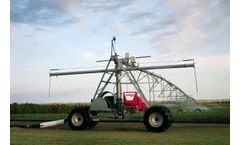Maize Yield Articles & Analysis
80 articles found
Treatment: Yield Check: 186 Bu AgZyme® with Ag Concepts® Super Hume®: 202 Bu Summary: Yield increase of 16 Bu/Acre with AgZyme® and Ag Concepts® Super Hume® Application: Ag Concepts® Super Hume® at a rate of 1 gallon per Acre and AgZyme® at a rate of 12.8 ounces per Acre. Both products were applied in furrow at planting with a liquid starter. All ...
Treatment: Yield Check: 197 Bu AgZyme® with Ag Concepts® Super Hume®: 221 Bu Summary: Yield increase of 25 Bu/Acre with AgZyme® and Ag Concepts® Super Hume® Application: 1 gallon per acre of Ag Concepts® Super Hume® with a liquid starter at planting. 2 quarts of Super Hume and 12.8 ounces of AgZyme® with a liquid starter at planting. The starter was ...
Key Difference between Lateral Move Irrigation and Centre Pivot Sprinklers, and What to Consider when Buying Lateral move irrigation systems, similar to center pivots, are a great solution for large fields. While center pivots rotate around a fixed point, laterals move continuously along the field’s length. This self-propelled design covers nearly 98% of the field area uniformly. The ...
Teosinte is a wild ancestor of maize, and its seed protein content is three times that of most modern maize lines. ...
Tackling Malawi's Hidden Hunger through Selenium and Iodine biofortification to green vegetables and conservation agriculture (CA) field crops Introduction In sub-Saharan Africa, micronutrient deficiencies are common in poor and rural areas, due to over-farmed, depleted soils and restricted diets. In Malawi, three-quarters of the population are selenium-deficient, which can lead to weakened ...
Proper weed control early during the growing season is essential for reducing nutrient competition, gaining optimal crop health, and preventing yield loss. Weed management in corn and soybeans can be an extremely difficult problem to tackle and, if left unmanaged, can cause nearly a 52% corn yield loss and 49% yield loss in soybeans according to research conducted by the Weed Science Society of ...
Every grower knows the value of stand count data in making replant decisions. But understanding stand count can also reveal critical insights about uniform emergence and plant spacing — both of which can have a substantial effect on yield potential. Even when stand count numbers are good, non-uniform corn emergence can reduce yield potential by as much as 10 percent. Similarly, non-uniform ...
In most of the US, this fall was a wet one. Chances are, you didn’t get much of a chance to get fall anhydrous in the ground. Beacuse of this, we wanted our agronomist, Barry Anderson, to answer a few of our burning questions related to fall nitrogen application. You may have missed the window this year, but here are some tips to keep in mind for next year. 1. At what rate/ ...
Agriculture degrades over 24 million acres of fertile soil every year, raising concerns about meeting the rising global demand for food. But a simple farming practice born from the 1930's Dust Bowl could provide a solution, according to new Stanford research. The study, published Dec. 6 in Environmental Research Letters, shows that Midwest farmers who reduced how much they overturned the soil -- ...
Indigo announced yield forecasts in January for corn and soybeans across the Americas, democratizing data for the grower community to better navigate global markets during the U.S. government shutdown. With the shutdown, the doors of the United States Department of Agriculture (USDA) had closed. No work in that department meant that there was an indefinite hold on a key report, known as the World ...
Today, we’re excited to announce Indigo’s acquisition of TellusLabs, a satellite imaging and artificial intelligence company based out of Somerville, Massachusetts. This joining of their mission with ours has been over a year-and-a-half in the making, and is a product of our Indigo Research Partners’ engagement with innovative startups around the world. Here’s the story of ...
Res. 12(3), 46-51, March 2018. To investigate the maize yield and nutrient concentration in its leaves as affected by biochar from different organic materials (wheat straw and sugarcane bagasse), a field experiment was conducted on maize crop during 2013 at koont research farm chakwal. ...
Will Hutchinson enjoys a good challenge, especially when it comes to improving production on his row crop, wheat and alfalfa farm near Murfreesboro, Tennessee. So when he saw the opportunity to leverage Ag Leader’s Hydraulic Down Force system to prevent a common problem and improve his planting operations on acres where he plants cover crops, he jumped at the chance. Two years later, ...
Daily high-resolution climate simulations from the Coordinated Regional Climate Downscaling Experiment_Regional Climate Models (CORDEX_RCMs) are used to drive the Decision Support System for Agro-technological Transfer (DSSAT) to simulate maize yields. Climate simulations for the base period of 35 years (1971–2005) are used to drive DSSAT to simulate ...
Uncertainties caused by climate change and population explosion require suitable methods for estimating grain yield during the growing seasons. This paper evaluates the applicability of the AquaCrop model in the region of western Kenya. The objectives of the study were to: simulate the long-term maize crop yields for the region using AquaCrop ...
Three irrigation treatments and four maize hybrids were studied. In the extremely rainy 2010, the highest yield of maize grain was obtained in rainfed plots (control = 9.24 t ha−1). A significantly (P < 0.01) lower yield (−8%) was obtained in fully irrigated plots (a3 = 8.59 t ha−1). This was opposite to the results obtained ...
A three‐year study was conducted on a corn field in Central Illinois, USA, to understand the fate and effects of an insecticidal formulation containing the active ingredients phostebupirim and cyfluthrin. The objectives of the current study were to 1) determine the best tillage practice (conventional versus conservation tillage) in terms of grain yields and potential environmental risk, 2) ...
Both shelled and unshelled maize yields responded positively to both water harvesting techniques and integrated nutrient management options. Tied-ridging had the highest positive effect on yield. A combined application of manure and inorganic fertilisers at either 5 or 10 t ha –1 plus 20 kg N plus 20 kg P 2 O 5 kg ha –1 had the most ...
As the 2013 corn crop was being planted, futures prices were above $6.00 a bushel with an occasional bump above $7.00. Traders were concerned that the planting problems farmers were experiencing would result in reduced production. By the end of July, with fewer concerns about the size of the corn crop, the priced dropped below $5.00. Since then the price has trended downward so that as this ...
Climate Change and Water Stress Exacerbate the Challenge Climate change is expected to negatively impact crop yields, particularly in the hungriest parts of the world, such as sub-Saharan Africa. ...














